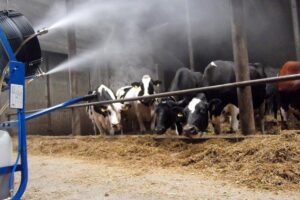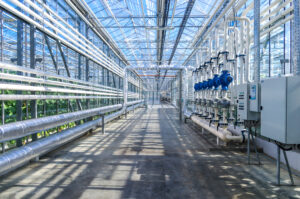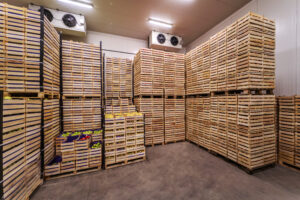Humidification
We design and implement industrial humidification of water mist air. We do not have realizations in large volumes of industrial and warehouse halls, where professional, fully automated installations are required. We also work for smaller customers who are too low humidity to negatively affect the final product, adapting proven solutions to their technical and financial capabilities.We offer customized automatic air humidification systems. Our systems will be found wherever relative humidity and temperature have a significant impact on working and production conditions.Humidification systems minimize the formation of electrostatic charges, improve the quality of the product, allow the maintenance of production technological regimes, and reduce the amount of dust in the air. The best marketing is the one where having a good product at a competitive price is a success. And we focus on such marketing in EKO-MET Paweł Rudziński. Most of our recipients are referral customers. Welcome.
Low pressure humidification
E-FOG and E-INDUSTRY
Low-pressure humidification is dedicated to production, in which haze, so-called dry mist, is important. The system developed by us operates at a pressure of 0.4 MPa and produces water mist with micron droplet sizes, which does not cause dew and moisture. It is characterized by excellent fog quality and trouble-free.
Especially recommended for:









































































































































































































































































































































































AERO MAX high pressure humid
ification
High-pressure humidification is dedicated to rooms with a significant volume. Water is subjected to a pressure of 50-70 bar, and then sprayed by specialized pressure nozzles. Thus, the obtained fog is characterized by drops of several to several microns. It is assumed that with such a droplet size, the evaporation area of each applied liter of water is more than 600 m2. Water takes heat from the environment and evaporates in a very short time, resulting in a rapid increase in relative humidity. Excellently reduces dust.
Especially recommended for:
























































































































































































































































































Features of fog humidifying systems:
























































































































































































































































































Advantages of fog humidifying systems:
























































































































































































































































































































































































































































































































































































































Low humidity in industry
Electrostatic charges
Humidity of less than 30% contributes to a significant increase in electrostatic charges on the type of surfaces that are dielectric (non-conductive). This situation most often occurs during the heating period. Frosty air from the outside is warmed up by heating devices to room temperature, resulting in a rapid decrease in its humidity. As a result of excessive accumulation of loads, damage to electronic equipment may occur, and there is a risk of fire or explosion of volatile substances and dust. An effective method of reducing electrostatic charges in a large industrial area is to increase the level of relative humidity of the air by using the e-Industry or AERO MAX air humidification system.
Storage problems
In the process of storing hygroscopic products, the water content is important, which – depending on the type of product – can range from 0.3-95%. The low temperature of the storage/cold store promotes the fixation of stored products, but at the same time does not affect the water content of them. This phenomenon occurs due to the differential partial pressures of water vapor. The process of moving the water mass from the inside of the product to the external surface and further into the storage environment takes place.
This problem occurs mainly in the storage of food products, but also in wood or tobacco. Loss of water from the product to the environment causes weight loss and decrease in quality, there is a phenomenon of removal, cracking and deformation in the case of wood-based products, paper, etc.
Pollination
In many industries, reduced relative humidity promotes the formation of volatile particulate matter. The reason for this phenomenon is m.in. accumulation of electrostatic charges and lowering the density of water-free material. Increasing the humidity level by using one of the three humidification systems in the plant will reduce pollination by reducing volatility and increasing particulate density and absorption of dust particles by drops of micron mist (volatile solid particles merge into larger groups losing their volatility).
This problem occurs mainly in the storage of food products, but also in wood or tobacco. Loss of water from the product to the environment causes weight loss and decrease in quality, there is a phenomenon of removal, cracking and deformation in the case of wood-based products, paper, etc.
Problems in the processes of varnishing and gluing
At a time when nitro varnishes are displaced for ecological reasons by water-refinishers or polyurethanes, proper relative humidity of the air is of paramount importance. When applying a coating, it is recommended that the relative humidity of the air is around 10 000 m2. 50-60%. Water varnishes applied at humidity of 20-30% create the effect of the so-called orange peel. This is due to the high water content of this type of varnish, which evaporates rapidly at low humidity levels, leading to surface tension, cracks and thus unintended coating effect, which reduces the aesthetic value of the product. A similar phenomenon occurs with polyurethane adhesives. In the bonding process, proper humidity is equally important. The result of incorrect gluing parameters in the carpentry industry is m.in. peel-off veneer, poor combination of furniture or window elements, which affects the service life of products and the number of complaints related to them.
Health and thermal comfort
In terms of comfort and health, the best level of relative humidity for a person is RH=40-60%. Humidity below this level causes a feeling of discomfort, excessive drying of the mucous membranes and, as a result, can cause respiratory diseases.
Low humidity in agriculture and horticulcy
Problems with an appropriate microclimate in animal husbandry


One of the most important parameters of the microclimate is temperature and relative humidity, which always go hand in hand. Exceeding adaptability in the event of high temperatures (hyperthermia) may be a risk to the health and life of animals. The use of humidifying systems in animal husbandry facilities allows air to be saturating with water mist, which in case of very high temperatures allows to reduce the ambient temperature by up to several degrees and save the herd.
Problems with low humidity in crops under cover


The HD (humidity deficiency) parameter, which indicates a water vapour deficit, is the amount of water vapour expressed in g/m3 that is missing at a given temperature to reach the so-called dew point. Optimal conditions in which plants grow and develop dynamically, have large weekly increases and are low prone to paralysis by gray mold, are conditions of balanced temperature and relative humidity of air. Serious problems arise when the humidity in the greenhouse drops below 30%. Plants get sick, inhibit growth or stop growing at all. In summer conditions, rapid evaporation of water mist allows the greenhouse to cool (cooling by evaporation), in case of low relative humidity, the use of a humidifying system will allow automatic control of the relative humidity level, thanks to sensors distributed in the object. The reduction in relative humidity levels in the object is immediately captured by sensors that signal to the system the need to start the nebula process. The system works until the entered parameters (the desired humidity level in the object) are obtained.
Problems with low humidity in food storage


Food products, whether animal or vegetable, irrespective of their degree of processing and perpetuation, shall be stored for a longer or shorter period of time after which they are delivered to the consignee. This process is related to both human physiology and the economics of production.A technological trend is to minimize food consolidation losses at every stage of this process. This is no different for freezing, cooling and storing food. The weight loss during these fixation processes is significant and does not have an impact on product quality and therefore economic losses. In the process of storing products, the water content is important, which , depending on the type of product, can range from 0.3-95%. The low temperature promotes the fixation of stored products, but at the same time it does not affect the water content in them. This phenomenon occurs due to the differential partial pressures of water vapor. The process of moving the water mass from the inside of the product to the outside surface and further to the cooling environment takes place. The weight loss of a stored food product during refrigeration is called a usuch of the product. This phenomenon is accompanied by a change in the physical and qualitative properties of the product.
We have developed and implemented many air humidification systems in cold rooms, peri-zero cold rooms and cold cold rooms. These systems are based on a base E-INDUSTRY product retrofitted with nebulae head heating. These installations do not require cooperation with air conditioners, they operate independently, based on the reading of air temperature and humidity and the data entered by the user. The controller analyses the data supplied by the humidity sensor and the climate parameters desired in the chamber and fully automatically regulates the nebula process by including or disabling the mist sets in the cold chamber.
